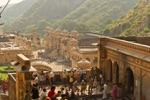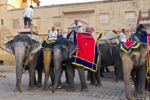India is in South Asia. It’s the seventh largest country by geographical area, the second most populous country with over 1.2 billion people, and the most populous democracy in the world.
Home to the ancient Indus Valley Civilization and a region of historic trade routes and vast empires, the Indian subcontinent was identified with its commercial and cultural wealth for much of its long history. Four of the world's major religions—Hinduism, Buddhism, Jainism, and Sikhism—originated there.
India came under the administration of the British East India Company from the early 18th century and administered directly by the United Kingdom from the mid-19th century. India became an independent nation in 1947 after a struggle for independence which was marked by non-violent resistance and led by Mahatma Gandhi.
As we well know, the Indian economy is the world's ninth-largest. Following market-based economic reforms in 1991, India became one of the fastest-growing major economies; it is considered a newly industrialized country. However, it continues to face the challenges of poverty, illiteracy, corruption, and inadequate public health.
In the Fall of 2011, I did my first trip to India. We stayed in the north central part of the country visiting Delhi, Jaipur, Pushkar and Agra. This was quite a different trip, and as I learned, visiting India is an experience unlike no other.











